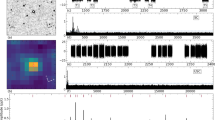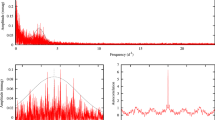Abstract—Pulsating stars are remarkable objects for stellar astrophysics. Their pulsation frequencies allow us to probe the internal structure of stars. One of the most known groups of pulsating stars is \(\delta \) Scuti variables which could be used to understand the energy transfer mechanism in A–F type stars. Therefore, in the current study, we focused on the discovery of \(\delta \) Scuti stars. For this investigation, we followed some criteria. First, we inspected TESS database by eye and discovered some single stars that exhibit pulsation like behaviour. Our second criterion is \({{T}_{{{\text{eff}}}}}\) and \(\log g\) range. The \(\delta \) Scuti stars generally have \({{T}_{{{\text{eff}}}}}\) and \(\log g\) value in a range of 6300–8500 K and 3.2–4.3, respectively. Hence, we selected the stars which have TIC \({{T}_{{{\text{eff}}}}}\) and \(\log g\) values in these ranges. The other criterion is the pulsating frequency. A frequency analysis was performed for all the candidate stars. In addition, \({{M}_{V}}\), \(L\) and also \({{M}_{{{\text{bol}}}}}\) parameters of the target stars were determined to calculate the pulsation constants and show their positions in the H–R diagram. The final pulsation type classification was made by considering the frequency ranges and pulsation constants of the stars. As a result of the study, five \(\delta \) Scuti, one \(\gamma \) Doradus and four hybrid systems were discovered.




Similar content being viewed by others
Notes
REFERENCES
C. Aerts, J. Christensen-Dalsgaard, and D. W. Kurtz, Asteroseismology. Astronomy and Astrophysics Library. (Springer Science+Business Media B.V., Springer Dordrecht, 2010).
E. B. Amôres and J. R. D. Lépine, Astron. J. 130 (2), 659 (2005).
V. Antoci,M. S. Cunha, D.M. Bowman, et al., Monthly Notices Royal Astron. Soc. 490 (3), 4040 (2019).
G. Á . Bakos, J. Lázár, I. Papp, et al., Publ. Astron. Soc. Pacific 114 (799), 974 (2002).
A. S. Baran and C. Koen, Acta Astronomica 71 (2), 113 (2021).
W. J. Borucki, D. Koch, G. Basri, et al., Science 327 (5968), 977 (2010).
M. Breger, Delta Scuti Star Newsletter 2, 13 (1990).
M. Breger, ASP Conf. Ser., 210, 3 (2000).
M. Breger and F. Beichbuchner, Astron. and Astrophys. 313, 851 (1996).
M. Breger, J. Stich, R. Garrido, et al., Astron. and Astrophys. 271, 482 (1993).
S.-W. Chang, P. Protopapas, D. W. Kim, and Y. I. Byun, Astron. J. 145 (5), id. 132 (2013).
M. A. Dupret, A. Grigahcène, R. Garrido, et al., Astron. and Astrophys. 414, L17 (2004).
M. A. Dupret, A. Grigahcène, R. Garrido, et al., Astron. and Astrophys. 435 (3), 927 (2005).
G. Handler, Monthly Notices Royal Astron. Soc. 398 (3), 1339 (2009).
G. Handler and R. R. Shobbrook, Monthly Notices Royal Astron. Soc. 333 (2), 251 (2002).
F. Kahraman Aliçavuş, E. Niemczura, P. De Cat, et al., Monthly Notices Royal Astron. Soc. 458 (3), 2307 (2016).
A. B. Kaye, G. Handler, K. Krisciunas, et al., Publ. Astron. Soc. Pacific 111 (761), 840 (1999).
P. Lampens, Y. Frémat, L. Vermeylen, et al., Bulletin de la Societe Royale des Sciences de Liege 87, 137 (2018).
P. Lampens, L. Vermeylen, P. De Cat, et al., in Proc. Conf. Stars and their Variability Observed from Space, Vienna, 2019, Ed. by C. Neiner, W. W. Weiss, D. Baade, R. E. Griffin, C. C. Lovekin, A. F. J. Moffat (University of Vienna, 2020), p. 353.
P. Lenz and M. Breger, Commun. Asteroseismology 146, 53 (2005).
A. Poro, E. Paki, G.Mazhari, et al., Publ. Astron. Soc. Pacific 133 (1026), id. 084201 (2021).
G. R. Ricker, J. N. Winn, R. Vanderspek, et al., J. Astronomical Telescopes, Instruments, and Systems 1, id. 014003 (2015).
E. Rodríguez and M. Breger, Astron. and Astrophys. 366, 178 (2001).
R. L. Smart et al. (Gaia Collab.), Astron. and Astrophys. 649, id. A6 (2021).
K. G. Stassun, R. J. Oelkers, M. Paegert, et al., Astron. J. 158 (4), id. 138 (2019).
K. Uytterhoeven, A. Moya, A. Grigahcène, et al., Astron. and Astrophys. 534, id. A125 (2011).
Funding
This work has been supported in part by the Scientific and Technological Research Council (TUBITAK) under the grant number 120F330.
Author information
Authors and Affiliations
Corresponding author
Ethics declarations
The authors declare no conflicts of interest.
Rights and permissions
About this article
Cite this article
Kιrmιzιtaş, Ö., Çavuş, S. & Aliçavuş, F.K. Discovery of New δ Scuti Stars. Astrophys. Bull. 77, 316–325 (2022). https://doi.org/10.1134/S1990341322030051
Received:
Revised:
Accepted:
Published:
Issue Date:
DOI: https://doi.org/10.1134/S1990341322030051




